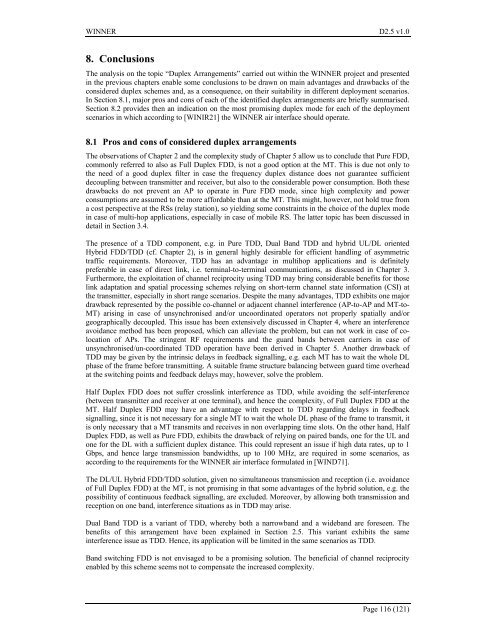IST-2003-507581 WINNER D2.5 v1.0 Duplex ... - Celtic-Plus
IST-2003-507581 WINNER D2.5 v1.0 Duplex ... - Celtic-Plus
IST-2003-507581 WINNER D2.5 v1.0 Duplex ... - Celtic-Plus
- No tags were found...
You also want an ePaper? Increase the reach of your titles
YUMPU automatically turns print PDFs into web optimized ePapers that Google loves.
<strong>WINNER</strong> <strong>D2.5</strong> <strong>v1.0</strong>8. ConclusionsThe analysis on the topic “<strong>Duplex</strong> Arrangements” carried out within the <strong>WINNER</strong> project and presentedin the previous chapters enable some conclusions to be drawn on main advantages and drawbacks of theconsidered duplex schemes and, as a consequence, on their suitability in different deployment scenarios.In Section 8.1, major pros and cons of each of the identified duplex arrangements are briefly summarised.Section 8.2 provides then an indication on the most promising duplex mode for each of the deploymentscenarios in which according to [WINIR21] the <strong>WINNER</strong> air interface should operate.8.1 Pros and cons of considered duplex arrangementsThe observations of Chapter 2 and the complexity study of Chapter 5 allow us to conclude that Pure FDD,commonly referred to also as Full <strong>Duplex</strong> FDD, is not a good option at the MT. This is due not only tothe need of a good duplex filter in case the frequency duplex distance does not guarantee sufficientdecoupling between transmitter and receiver, but also to the considerable power consumption. Both thesedrawbacks do not prevent an AP to operate in Pure FDD mode, since high complexity and powerconsumptions are assumed to be more affordable than at the MT. This might, however, not hold true froma cost perspective at the RSs (relay station), so yielding some constraints in the choice of the duplex modein case of multi-hop applications, especially in case of mobile RS. The latter topic has been discussed indetail in Section 3.4.The presence of a TDD component, e.g. in Pure TDD, Dual Band TDD and hybrid UL/DL orientedHybrid FDD/TDD (cf. Chapter 2), is in general highly desirable for efficient handling of asymmetrictraffic requirements. Moreover, TDD has an advantage in multihop applications and is definitelypreferable in case of direct link, i.e. terminal-to-terminal communications, as discussed in Chapter 3.Furthermore, the exploitation of channel reciprocity using TDD may bring considerable benefits for thoselink adaptation and spatial processing schemes relying on short-term channel state information (CSI) atthe transmitter, especially in short range scenarios. Despite the many advantages, TDD exhibits one majordrawback represented by the possible co-channel or adjacent channel interference (AP-to-AP and MT-to-MT) arising in case of unsynchronised and/or uncoordinated operators not properly spatially and/orgeographically decoupled. This issue has been extensively discussed in Chapter 4, where an interferenceavoidance method has been proposed, which can alleviate the problem, but can not work in case of colocationof APs. The stringent RF requirements and the guard bands between carriers in case ofunsynchronised/un-coordinated TDD operation have been derived in Chapter 5. Another drawback ofTDD may be given by the intrinsic delays in feedback signalling, e.g. each MT has to wait the whole DLphase of the frame before transmitting. A suitable frame structure balancing between guard time overheadat the switching points and feedback delays may, however, solve the problem.Half <strong>Duplex</strong> FDD does not suffer crosslink interference as TDD, while avoiding the self-interference(between transmitter and receiver at one terminal), and hence the complexity, of Full <strong>Duplex</strong> FDD at theMT. Half <strong>Duplex</strong> FDD may have an advantage with respect to TDD regarding delays in feedbacksignalling, since it is not necessary for a single MT to wait the whole DL phase of the frame to transmit, itis only necessary that a MT transmits and receives in non overlapping time slots. On the other hand, Half<strong>Duplex</strong> FDD, as well as Pure FDD, exhibits the drawback of relying on paired bands, one for the UL andone for the DL with a sufficient duplex distance. This could represent an issue if high data rates, up to 1Gbps, and hence large transmission bandwidths, up to 100 MHz, are required in some scenarios, asaccording to the requirements for the <strong>WINNER</strong> air interface formulated in [WIND71].The DL/UL Hybrid FDD/TDD solution, given no simultaneous transmission and reception (i.e. avoidanceof Full <strong>Duplex</strong> FDD) at the MT, is not promising in that some advantages of the hybrid solution, e.g. thepossibility of continuous feedback signalling, are excluded. Moreover, by allowing both transmission andreception on one band, interference situations as in TDD may arise.Dual Band TDD is a variant of TDD, whereby both a narrowband and a wideband are foreseen. Thebenefits of this arrangement have been explained in Section 2.5. This variant exhibits the sameinterference issue as TDD. Hence, its application will be limited in the same scenarios as TDD.Band switching FDD is not envisaged to be a promising solution. The beneficial of channel reciprocityenabled by this scheme seems not to compensate the increased complexity.Page 116 (121)
















